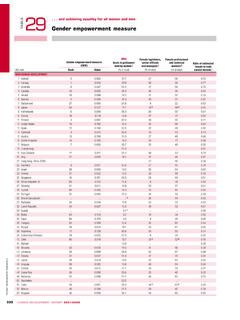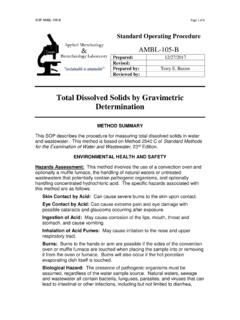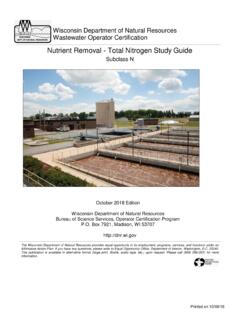Transcription of TOTAL DISSOLVED SOLIDS MEASUREMENT - IC Controls
1 TOTAL DISSOLVED SolidsDefinition: TOTAL DISSOLVED SOLIDS (TDS) is ameasure of the sum of all inorganic and organicsubstances in a liquid in molecular, ionized ormicro-granular colloidal suspended form. Thesolids must be small enough to survive filtrationthrough a sieve the size of two micrometer. TDS SOLIDS are normally found in all freshwatersystems. Major applications of TDS are: at lowlevels the study of water quality for streams, rivers,lakes, potable water taste, and at high levels thecontrol of scale in recirculating water systems. It isa quality indicator for drinking water and is ageneral measure of the presence of chemicals. Inseawater RO desalination, TDS provides a way ofcomparing the feed with the permeate quality thatis relevant to drinking water taste standards. Where does TDS come from?TDS in surface waters come from the solventaction of water in contact with minerals in theearth, agricultural and residential runoff, leachingof soil contamination, and used water fromindustrial or sewage treatment plants.
2 Commonchemical constituents are calcium, sodium,chloride, potassium, phosphates and nitrates. Theymay be cations, anions, molecules oragglomerations of molecules, so long as they aresoluble. The United States and Canada have asecondary water quality standard of 500 mg/L TDSor less for palatable drinking water. Water withTDS of greater than 500 mg/L may have poor tasteand when over 1500 mg/L will taste like weakAlka-Seltzer to most people. TOTAL suspended SOLIDS (TSS), are different fromTDS as they cannot pass through a sieve of twomicrometers and are suspended in and sand filtration can remove settle-able SOLIDS and suspended SOLIDS from the water butdissolved TDS SOLIDS are not in Water SystemsTDS enters recirculating water systems with thewater supply from municipal, lake, river, or wellwater. Once inside evaporation of a portion of therecirculating water concentrates TDS SOLIDS .
3 HighTDS levels generally indicate hard water, waterhardness must be removed or will cause scalebuildup in pipes, valves, and filters, reducingperformance and adding to boiler systemmaintenance and efficiency costs. TDS isfrequently tested manually and by continuous TDSanalyzer which operates a blowdown valve to keepthe system below the scale effects can also be seen in aquariums, spas,swimming pools, and reverse osmosis watertreatment systems. Typically, in these applications,TDS is tested manually frequently or by continuousTDS analyzer, plus equipment and filtrationmembranes are inspected for aquaculture, TDS is monitored to create a water29 Centennial Road Orangeville Ontario L9W 1R1 Tel:(519)941-8161 Fax:(519)941-8164 DISSOLVED SOLIDS MEASUREMENTI llustration: 210-C analyzer configured to measure environment suitable for the organism.
4 Forfreshwater oysters, trouts, and other high valueseafood, highest productivity and economic returnsare achieved by mimicking the TDS and pH levelsof each species' native environment. In hydroponics, TOTAL DISSOLVED SOLIDS is consideredone of the best indicators of nutrient availability forthe plants being MEASUREMENT MethodsThere are two principal methods of measuring totaldissolved SOLIDS : gravimetic and conductivity. Thestandard method is gravimetric, which isconsidered the most accurate and involvesevaporating the sample to dryness at 103 C, thento 180 C to remove any occluded water, (watermolecules trapped in mineral matrix), thenweighing it with a precision analytical balance(normally capable of gram accuracy). Thismethod is generally considered best, although it isslow and has inaccuracies from low-boiling-pointchemicals which evaporate with the of water is directly related to the conductivityof DISSOLVED ionized SOLIDS in the water.
5 Ions fromthe DISSOLVED SOLIDS create the ability for water toconduct an electrical current, which is measured bythe IC Controls 210-C(TDS) analyzer, andimmediately displayed as sodium chloride ppm ormg/L or S/cm conductivity. When periodicallystandardized with IC Controls TDS standards or bylaboratory gravimetric TDS MEASUREMENT , TDSanalyzers based on conductivity provide a quickaccurate value of the in BoilersAs a boiler generates steam, TDS impurities whichare in the feedwater do not boil off with the impurities concentrate in the boiler water,building up to produce scale just like in a kettle. Asthe DISSOLVED SOLIDS become more concentrated, thesteam bubbles formed are more stable, failing topop when they reach the water surface in the depending on boiler pressure, size, andsteam load, some of the steam space in the boilerfills with bubble foam which may get carried overinto the main steam pipe.
6 This is dangerousbecause now the steam is wet as it leaves the boiler,en-training bubbles filmed by high-TDS boilerwater. The TDS SOLIDS will contaminate controlvalves, heat exchangers, steam traps, and most common cause of carryover is a highTotal DISSOLVED SOLIDS (TDS) level. Foaming canalso be caused by high levels of suspended SOLIDS ,high alkalinity or contamination by oils and control of boiler water TDS levels, plusperiodic checks for contaminants should ensureminimal risk of foaming and avoid carryover, boiler manufactures typicallyspecify maximum TDS based on operatingpressure. For drum type boilers:Drum Pressure PSIGMax Boiler Water TDSUp to 300700 to 3500 ppm (mg/L)from 300 to 450600 to 3000 ppm (mg/L)from 450 to 600500 to 2500 ppm (mg/L)from 600 to 750200 to 2000 ppm (mg/L)from 750 to 900150 to 1500 ppm (mg/L)from 900 to 1000125 to 1250 ppm (mg/L)from 1000 to 1800100 ppm (mg/L)Too high TDS, besides carryover, can result inscale deposits on the boiler heat of the type of scale deposited boilerheat surfaces all exhibit a lowered ability totransmit heat.
7 Studies publisher by water treatmentchemical companies have shown that 3 mm( inch) of scale thickness causes about 2 to3 % boiler efficiency loss. Not only does it adddirectly to the fuel bill, but also the slowed heattransfer from hot gas to boiler water results inhigher temperature in the tube metal, and possibletube failure, boiler outage, and costly Centennial Road Orangeville Ontario L9W 1R1 Tel:(519)941-8161 Fax:(519)941-8164 when TDS is measured on line by theIC Controls 210-C(TDS) analyzer, andcontinuously displayed as ppm TDS or mg/L or canalso be displayed as S/cm conductivity, there isreason to expect scale deposition can be TDS is measured on line and control(blowdown) automated with the TDS set point setin consultation with your boiler specialty chemicalsupplier, scale deposits can be eliminated, savingfuel and maintenance sampling for off line analysisEven with continuous TDS monitoring, periodicsamples should be collected as a check, plus withgravimetric analysis it can be used to standardizethe TDS analyzer.
8 Standardizing adjusts the TDSsolids content factor, which can change withchanges in water supply source or chemicaltreatment. When collecting a sample it is importantto ensure that you get a representative have a connection for surface or TDSblowdown, which is a good place to obtain arepresentative sample. Samples from close to theboiler feedwater inlet could give a false from level gauge glasses or externalcontrol chambers may contain condensate andshould be sample water is simply drawn from the boiler, itwill violently flash to steam as its pressure isreduced. Not only is this potentially very dangerousto the operator, but any subsequent analysis willalso be wrong due to the loss of the flashed steamconcentrating the get a cooled sample for analysis, a samplecooler such as the IC Controls 501 (see nearbyillustration) will be required. The 501 samplecooler is a small heat exchanger that uses coldwater to cool the boiler water sample below theflash is meant by neutralized conductivity?
9 Boiler water typically contains hydroxyl (OH-) ionalkalinity from high pH. The OH- ion has very highconductivity but is a dissociate of H2O so does notcontribute to TDS. The OH- ion conductivity can beeliminated by reducing the pH to 7 or neutralizingthe sample with an organic acid such as gallic oracetic acid. Organic acids contribute a negligibleamount to conductivity of water in the boiler. What is the relationship between TDS and conductivity?TDS ions from DISSOLVED SOLIDS create the abilityfor water to conduct an electrical current, which ismeasured by the IC Controls 210-C(TDS) andimmediately displayed as sodium chloride ppm ormg/L, or as a conductivity analyzer displayed as S/cm. When directly measured in process theconductivity detected is not Controls 210-C has an adjustable SCF solidscontent factor to match your non neutralized TDS SOLIDS content factors:TDS as NaCl: to as 442 : to as KCl: to Centennial Road Orangeville Ontario L9W 1R1 Tel:(519)941-8161 Fax:(519)941-8164 Cooler 501 Typical neutralized TDS Conversion Factors:TDS as NaCl: to as KCl: to treatment chemicals and dispersant can causesignificant variations specific to each plant.
10 In themore concentrated boiler water the SOLIDS contentfactor typically is found between and ppmTDS per S/cm. The water treatment companyshould be consulted and periodic gravimetric TDStests done to confirm the SOLIDS content factor is the difference between ppm and mg/L?Parts per million TDS or ppm (abbreviated) is anexpression of quantity, mg/L (milligrams per liter)is an expression of weight. Both are used as scalesfor TDS, but ppm is more popular. There is noconversion factor since 1 ppm = 1 can you calibrate a TDS analyzer?Two ways: 1)The gravimetric method is considered themost accurate and involves evaporating thesample to dryness at 103 C, then to 180 Cto remove any occluded water, thenweighing it with a precision balancecapable of gram. Gravimetricanalysis is best, although slow, and hasinaccuracies from evaporation of lowboiling point chemicals.






